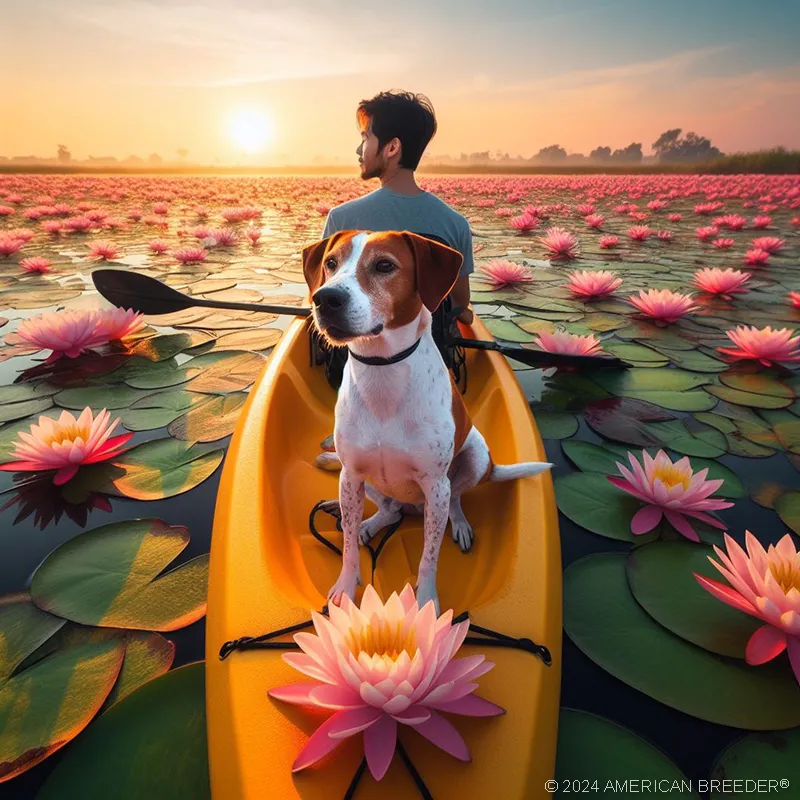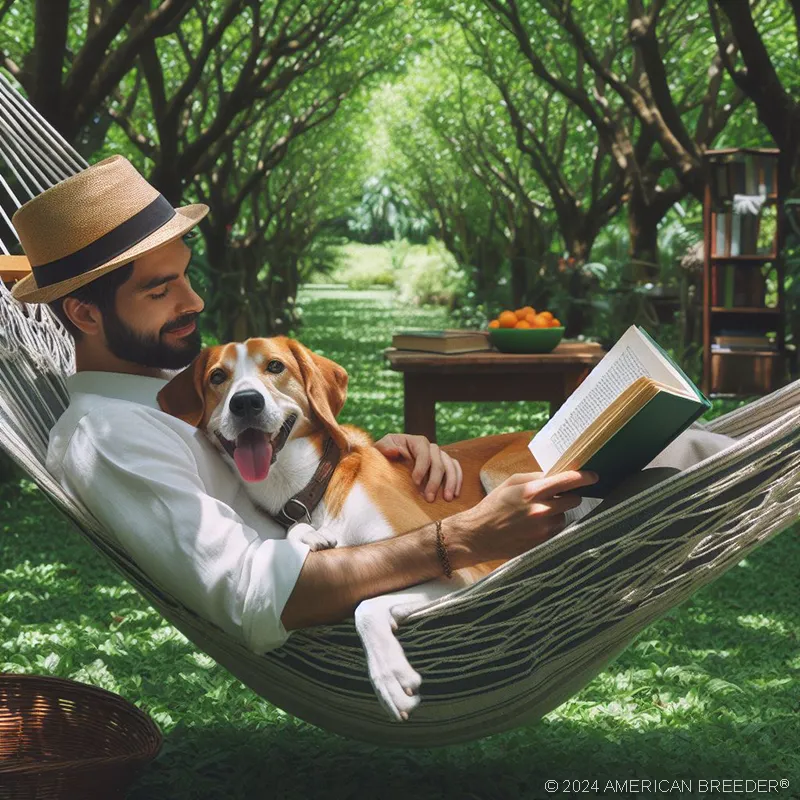The Playful Harrier Hound Dog
Introduction and Breed Background
 Prepare to meet the Harrier Dog, an energetic hound that's about to fill your life with boundless joy and playful antics! This delightful breed is like a ray of sunshine, radiating warmth and affection wherever it goes. But before you dive headfirst into the world of Harriers, let's take a closer look at what makes them such a captivating and cherished canine companion.
Prepare to meet the Harrier Dog, an energetic hound that's about to fill your life with boundless joy and playful antics! This delightful breed is like a ray of sunshine, radiating warmth and affection wherever it goes. But before you dive headfirst into the world of Harriers, let's take a closer look at what makes them such a captivating and cherished canine companion.
Harrier Dogs, often referred to as "Beagles on steroids," are medium-sized scent hounds with an undeniably athletic spirit. Their history dates back to 13th-century England, where they were selectively bred for their keen sense of smell and tenacity in tracking down hares and foxes. Over the centuries, they have proven to be exceptional hunters and unwaveringly loyal companions, making them a treasured part of hunting communities.
Fun Fact: Beyond their renowned hunting prowess, Harrier Dogs have made appearances in various art forms, including literature, paintings, and even movies, such as the lovable Harrier named Copper in the classic Disney film "The Fox and the Hound."
Breed Background and History
The fascinating history of the Harrier Dog is like an enthralling tale passed down through generations. These hounds have been by humanity's side for centuries, sharing in our triumphs and adventures. Rooted in the English countryside, Harriers were the go-to companions for foxhunts, where their exceptional tracking abilities proved invaluable. Their name, "harrier," directly relates to their purpose - haring or hunting hares.
As the centuries passed, the Harrier Dog's reputation as a skilled hunter earned it the admiration of many, and it became increasingly popular as a family companion. Their sweet and affectionate nature made them cherished members of households, where they proved their worth as loving and loyal friends.
Today, the Harrier Dog is recognized and cherished by various kennel clubs, including the American Kennel Club (AKC) and the United Kennel Club (UKC), which highlights their enduring appeal across borders.
Appearance
One look at a Harrier Dog, and you'll be captivated by its athletic and sleek physique. Standing at about 19 to 21 inches tall and weighing between 45 to 60 pounds, these hounds are medium-sized powerhouses, ready to take on any adventure life throws their way.
 With their short and dense coat, Harriers are low-maintenance when it comes to grooming, requiring only occasional brushing to keep their coat looking its best. Their coat comes in various attractive color combinations, from classic tri-color (black, tan, and white) to the striking red and white, and the beautiful lemon and white.
With their short and dense coat, Harriers are low-maintenance when it comes to grooming, requiring only occasional brushing to keep their coat looking its best. Their coat comes in various attractive color combinations, from classic tri-color (black, tan, and white) to the striking red and white, and the beautiful lemon and white.
A hallmark of the Harrier's charm is its expressive eyes, usually in warm shades of brown or hazel, which perfectly complement its friendly and affectionate disposition.
Fun Fact: The Harrier Dog's coat isn't just for aesthetics - it offers protection against thorny bushes and other harsh elements during their hunting days!
The average litter size for Harrier Dogs typically ranges from 4 to 7 puppies, making each new addition to the Harrier family a joyous occasion.
Temperament and Personality
The Harrier Dog's temperament is like a heartwarming melody that resonates with everyone it meets. Friendly, outgoing, and full of energy, these hounds are born to bring happiness to the lives of their human companions. Whether you're an active family, a solo adventurer, or anything in between, the Harrier will embrace your lifestyle with open paws.
This breed's love for socializing knows no bounds, and they genuinely enjoy the company of children and other pets when introduced early on. The Harrier's affectionate nature makes it an exceptional family dog that will never miss an opportunity for cuddles and belly rubs.
While their playful and mischievous side is undeniably endearing, it's essential to provide them with consistent training and constructive outlets for their energy to ensure they grow into well-behaved and balanced adults.
Behavior Issues: As with any breed, the Harrier Dog may encounter some behavioral challenges, such as excessive barking, digging, and resource guarding. Early training and socialization can address these tendencies and help them mature into well-mannered members of the family.
Trainability and Intelligence
Intelligence and trainability go paw-in-paw when it comes to the Harrier Dog. These hounds possess a keen intellect and a willingness to please their human companions, making training sessions an enjoyable and fruitful experience for both parties.
 Positive reinforcement training is the name of the game with Harriers. They respond exceptionally well to praise, treats, and play as rewards for mastering new commands. Keep training sessions engaging and filled with enthusiasm, and your Harrier will become a star pupil in no time!
Positive reinforcement training is the name of the game with Harriers. They respond exceptionally well to praise, treats, and play as rewards for mastering new commands. Keep training sessions engaging and filled with enthusiasm, and your Harrier will become a star pupil in no time!
Their problem-solving abilities are also worth mentioning, making them adept at learning various tricks and skills. Enroll them in activities like agility, tracking, and obedience trials, and watch them excel in these exciting canine sports!
Practical Considerations
Welcoming a Harrier Dog into your home is like inviting a burst of energy and affection. As they love to play and run, a spacious home with a fenced yard will be a perfect match for their active lifestyle. However, if you live in an apartment or a house without a yard, don't worry! Regular outdoor exercise and stimulating play sessions will keep them content and happy.
Energy Level: Be prepared to match your Harrier's energy as they require at least 60 to 90 minutes of exercise daily. A long hike or a game of fetch will surely keep their wagging tails even happier!
Size of Sleeping Quarters: While they may enjoy sprawling on the couch for a nap, providing them with a comfortable dog bed gives them a cozy spot to rest after their adventures.
Grooming: Their short coat is relatively easy to maintain, requiring only occasional brushing to remove loose hair and keep their coat looking polished. Regular ear cleaning and dental care are also crucial to their overall health.
Affection Level and Attention: As social butterflies, Harrier Dogs crave affection and attention from their human family. Be ready to shower them with love, and they'll return it tenfold!
Health and Care
Keeping your Harrier Dog healthy and happy is like caring for a dear friend. While they are generally a healthy breed, there are some health issues to be aware of. Regular check-ups with a veterinarian, a balanced diet, and a loving home environment are key to their well-being.
Common Health Issues: Harrier Dogs may be prone to hip dysplasia, eye problems, and ear infections. Regular vet visits and a watchful eye can help catch any potential issues early on.
 Allergies and Dietary Considerations: Some Harriers may be prone to allergies, so it's essential to provide them with a suitable diet. Your vet can recommend the best food options to keep them healthy and thriving.
Allergies and Dietary Considerations: Some Harriers may be prone to allergies, so it's essential to provide them with a suitable diet. Your vet can recommend the best food options to keep them healthy and thriving.
Exercise Needs: Harriers have a zest for life and require both physical and mental stimulation to stay happy. Regular exercise and interactive playtime are vital to keeping them engaged and content.
Nutrition and Feeding Guidelines: Opt for high-quality dog food appropriate for their age, size, and activity level. Always follow the feeding guidelines on the packaging, and don't forget to provide them with fresh water throughout the day.
Socialization and Compatibility
The Harrier Dog's social and amiable nature makes it an excellent companion for various family dynamics. Whether you have kids, other pets, or live in a bustling neighborhood with many visitors, the Harrier will happily embrace them all. Early socialization is vital to ensure they grow up to be well-adjusted and friendly adult dogs.
Interacting with Children: Harrier Dogs adore children and often form deep bonds with them. However, as with any dog, supervision is necessary to ensure playtime remains safe and enjoyable for both the dog and the child. Teach children how to approach and handle the dog gently, and you'll have a furry best friend for life!
Getting Along with Other Pets: Harriers usually get along well with other pets, especially when introduced at a young age. However, it's essential to monitor their interactions and provide a gradual introduction, allowing the animals to acclimate to each other's presence.
Socialization Needs: Exposing your Harrier to various sights, sounds, and environments from an early age will help them become more confident and less prone to anxiety in unfamiliar situations. Take them to the park, on walks, and invite friends and their pets for playdates.
Precautions for Multi-Dog Households: Harriers can be a bit competitive when it comes to play and food. Supervise playtime and feeding to ensure a harmonious atmosphere, and consider feeding them separately if any resource guarding behaviors emerge.
Living Arrangements and Environment
The Harrier Dog's adaptability allows it to thrive in various living arrangements, from apartments to houses and even rural areas. However, their energetic nature means they need plenty of space for exercise, so access to a secure backyard or nearby open spaces is a definite plus.
 Apartment Living: Living in an apartment with a Harrier can be a great fit, provided they get enough daily exercise. Plan for regular walks, trips to the dog park, or interactive play sessions to keep them happy and healthy.
Apartment Living: Living in an apartment with a Harrier can be a great fit, provided they get enough daily exercise. Plan for regular walks, trips to the dog park, or interactive play sessions to keep them happy and healthy.
House and Yard Space: If you have a house with a fenced yard, your Harrier will be in doggy paradise! They can freely frolic and explore the outdoors, which will satisfy their active and curious nature.
Climate Considerations: Harrier Dogs can adapt to different climates, but they may prefer moderate temperatures. Be mindful of extreme weather conditions and take appropriate measures to keep them comfortable, such as providing shade and fresh water during hot days.
Ideal Yard Size: A medium to large yard will suit a Harrier's playful demeanor best, giving them ample room to chase toys, run around, and indulge in their natural instincts.
Training and Obedience
Training a Harrier Dog is like going on a rewarding journey together. Their intelligence and eagerness to please their humans make them eager students, but they can also be a bit headstrong. Consistency, positive reinforcement, and patience will make the training process smoother and more enjoyable for both of you.
Basic Obedience: Start with the basics, such as sit, stay, come, and leash walking. These commands will establish the foundation for good behavior and make your Harrier a well-mannered companion.
Advanced Training: Harrier Dogs excel in various canine sports, such as agility, tracking, and obedience trials. Engaging in these activities will not only keep them physically fit but also mentally stimulated and content.
Behavioral Challenges: Address any behavioral challenges, such as excessive barking or digging, with positive reinforcement and redirection. Harriers respond best to rewards and praise, so focus on encouraging desired behaviors.
Overall Summary
 The Harrier Dog is a vivacious and friendly breed that brings boundless joy and laughter to any home. From its historic hunting roots to its modern-day role as a beloved family companion, the Harrier is a loyal and affectionate friend who craves adventure and loves to be in the midst of all the action.
The Harrier Dog is a vivacious and friendly breed that brings boundless joy and laughter to any home. From its historic hunting roots to its modern-day role as a beloved family companion, the Harrier is a loyal and affectionate friend who craves adventure and loves to be in the midst of all the action.
So, get ready for a life of wagging tails, heartwarming cuddles, and unforgettable moments with your playful Harrier! With proper care, training, and lots of love, this delightful hound will be your loyal companion on every journey, turning your life into a thrilling and heartwarming tale of a lifetime shared with a beloved furry friend.
Conclusion
Embarking on the journey of welcoming a Harrier Dog into your life is like opening a treasure chest filled with love, joy, and delightful adventures. With their playful and affectionate nature, they are the perfect furry companions for active families, solo adventurers, and everyone in between.
Remember, responsible ownership is the key to nurturing a loving bond with your Harrier. From socialization to training, providing the best care and love will result in a faithful friend who will be your partner in crime, confidant, and a source of unconditional love.
So, open your heart and your home to this charismatic and athletic breed, and get ready for a life filled with countless cherished memories, all shared with your beloved Harrier Dog by your side!
Harrier Dog Quick Reference Guide
Breed Background: Origin: England | Breed Purpose: Hunting hare and small game | AKC Class: Hound Group | Year Recognized by AKC: 1885
 Appearance: Size: Medium | Weight: 45-60 pounds | Coat Type: Short and dense | Colors & Patterns: Tricolor (white, black, and tan) | Distinctive Features: Long ears and expressive eyes
Appearance: Size: Medium | Weight: 45-60 pounds | Coat Type: Short and dense | Colors & Patterns: Tricolor (white, black, and tan) | Distinctive Features: Long ears and expressive eyes
Temperament: Energy Level: 4 | Friendliness to Pets: 4 | Friendliness to Strangers: 3 | Trainability: 3 | Playfulness: 5 | Frequent Barker: 3 | Chase Instincts: 5 | Sense of Smell: 5 | Drive to Hunt: 5
Health & Care: Health Issues: Generally healthy, may have hip dysplasia | Lifespan: 12-15 years | Grooming Difficulty: Low | Exercise Needs: High
Socialization: Interaction with Children: Good, playful and gentle | Interaction with Pets: Good, gets along with other dogs | Interaction with Strangers: Reserved, may be aloof | Ease of Training: Moderate
Suitable Living Arrangements: Apartment: No | House: Yes | Rural Area: Preferred | Yard Size Requirements: Medium to large yard needed
Training & Obedience: Trainability: 3 | Intelligence: 3 | Obedience: 3 | Problem-Solving: 3 | Easily Stimulated: 4 | Focus Level: 3 | Easily Distracted: 3
Financial Planning: Typical Price Range: $800 - $1200 | Initial Expenses: Vaccinations, crate, and basic supplies | Ongoing Annual Expenses: Food, grooming, and vet visits
Breeding: Reproductive Maturity: 6-12 months | Litter Frequency: 1-2 per year | Litter Size: 5-7 puppies | Stud Cost: $500 - $1000 | Breeding Challenges: Finding suitable mates due to their rarity
Did You Enjoy this Article? Share it and Help Us Spread the Word!
If you found this article helpful, we'd appreciate it if you could share it with your friends or link to it from your website, blog, or group! You can also use the convenient social share tabs on the left side of the screen to instantly share this page to your social media feed. For more ways to support and promote the American Breeder Community, visit our Share & Promote Together page for social media posts and memes you can copy and share. Your support means the world to us!
Disclaimer: The information provided in this article is for general informational purposes only and does not constitute legal, medical, financial, or professional advice. While we strive for accuracy, we make no representations or warranties regarding the completeness, accuracy, reliability, or suitability of the information. Please consult with a professional before making decisions based on the content provided. American Breeder Inc. assumes no responsibility for any errors or omissions or for the results obtained from the use of this information.
